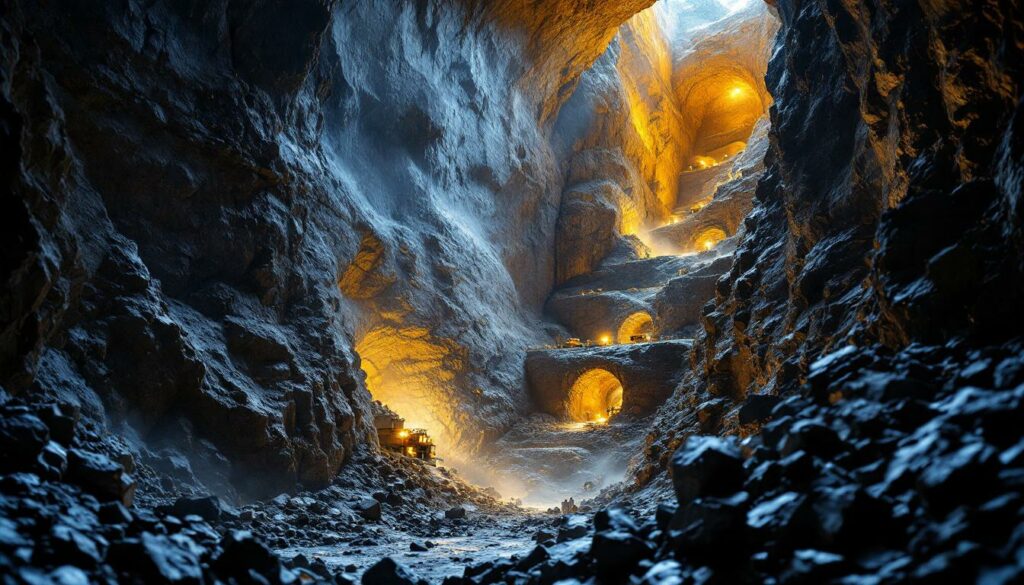What is Sublevel Caving Mining?
Sublevel caving is an underground mass mining method that involves the controlled caving of overlying rock as ore is extracted. This mining technique strategically divides the orebody into vertical slices, with extraction proceeding systematically from top to bottom. As mining progresses, the hangingwall rock is allowed to progressively cave into the void created by ore removal, creating a continuous cycle of extraction and controlled collapse.
The method relies on gravity to assist in ore movement, making it particularly effective for certain geological formations. Production typically occurs from multiple sublevels simultaneously, with each level consisting of parallel drifts from which fan drilling and blasting take place.
Definition and Basic Principles
Sublevel caving operates on the principle of induced, controlled cave propagation. After blasting, the fragmented ore is loaded from drawpoints, while the hangingwall material progressively caves to fill the void. This continuous process requires careful management to maximize ore recovery while minimizing dilution from waste rock.
"Successful sublevel caving depends heavily on the ability of the hangingwall rock mass to cave spontaneously after ore extraction," notes Mining Doc (2023). This balance between extraction and caving progression is critical to the method's success.
The technique employs a systematic approach where production drifts are developed at regular vertical intervals (sublevels), typically spaced 25-40 meters apart depending on geological conditions suitable for sublevel caving method. From these drifts, drilling fans extend upward to create a blasting pattern that facilitates controlled fragmentation.
Historical Development and Evolution
Sublevel caving has evolved significantly since its early applications in the mid-20th century. While originally relying on labor-intensive methods with manual drilling and rudimentary loading equipment, modern sublevel caving operations incorporate advanced technologies that have revolutionized efficiency, safety, and recovery rates.
Today's operations feature automated drill rigs with computerized controls, LHD (Load-Haul-Dump) machines with remote operation capabilities, and sophisticated ore pass systems. These technological advancements have enabled mining at greater depths and in more challenging geological environments than ever before.
Modern sublevel caving also incorporates advanced monitoring systems that track cave progression using microseismic monitoring networks, providing real-time data on rock mass behavior. Enhanced draw control strategies utilize this data-driven operations to optimize extraction sequences and minimize dilution, representing a significant evolution from the more empirical approaches of the past.
Why is Orebody Geometry Critical for Sublevel Caving?
The three-dimensional geometry of an orebody profoundly influences the applicability and efficiency of sublevel caving. Not all deposits are suitable for this mining method, with specific geometric characteristics determining whether sublevel caving will be technically feasible and economically viable.
Optimal Dip Requirements
Sublevel caving performs best in steeply dipping orebodies with inclinations exceeding 60°. This steep angle is not merely preferable but often essential for successful implementation of the method. At these inclinations, gravitational forces facilitate natural material flow and significantly reduce dilution during the extraction process.
"When the dip falls below 60°, material flow becomes increasingly problematic, potentially leading to higher dilution rates and reduced recovery," explains Mining Doc (2023). The steeper the dip, the more efficiently the broken ore will flow to drawpoints, and the more effectively the waste rock will cave to fill the created void.
In orebodies with less favorable dips (between 45-60°), modifications to the standard sublevel caving approach may be necessary, including closer level spacing and modified draw strategies. These adaptations typically increase development costs and operational complexity.
Thickness and Continuity Considerations
The method is particularly effective for massive, thick deposits with relatively consistent mineralization. Ideally, orebodies should have sufficient thickness (typically >10m) to justify the development costs and to maintain efficient extraction sequences.
Thin orebodies (<10m) generally don't provide sufficient economic return to justify the extensive development required for sublevel caving. Additionally, ore continuity plays a crucial role in method selection. Discontinuous orebodies with frequent barren zones may experience excessive dilution, as the caving process cannot selectively avoid waste inclusion.
The relative consistency of grade distribution throughout the orebody geometry guide also influences the applicability of sublevel caving. Since the method involves mass mining with limited selectivity, highly variable grade distributions may result in excessive dilution of high-grade zones or inclusion of sub-economic material.
Influence of Orebody Shape on Mine Design
The orebody's three-dimensional geometry directly influences sublevel spacing, drift layout, and overall mine design. Irregular shapes may require adaptations to standard sublevel caving approaches, potentially affecting recovery rates and dilution.
Complex orebody boundaries present particular challenges, as they can create irregular cave fronts that are difficult to manage. In such cases, customized drift layouts and specialized draw strategies may be necessary to maintain acceptable recovery and dilution levels.
The lateral extent of the orebody also impacts mine design considerations. Wider orebodies may require multiple parallel drifts on each sublevel, increasing development requirements but potentially improving extraction efficiency through multiple draw points.
How Does Rock Mass Cavability Affect Sublevel Caving Success?
The propensity of the overlying rock mass to cave in a controlled, predictable manner represents perhaps the most critical geological factor in sublevel caving operations. Without proper caving behavior, the method can experience serious operational problems including ore dilution, recovery losses, and safety hazards.
Measuring and Predicting Cavability
Rock mass cavability is assessed through geotechnical classification systems, structural analysis, and numerical modeling techniques. Key parameters include rock mass rating (RMR), geological strength index (GSI), and the presence of natural fractures or discontinuities.
These assessment tools help engineers quantify the rock mass's propensity to cave under specific conditions. The Q-system and RMR classifications provide numerical values that correlate with expected caving behavior, while structural mapping identifies potential failure planes that may facilitate or impede caving.
Advanced numerical modeling techniques, including discrete element modeling (DEM) and finite element analysis (FEA), allow engineers to simulate caving behavior under various mining scenarios. These models incorporate rock mass properties, in-situ stress conditions, and extraction sequences to predict caving progression rates and potential problems.
Stress Caving vs. Subsidence Caving Mechanisms
Two primary caving mechanisms operate in sublevel caving: stress-induced caving (where rock fails due to stress redistribution) and gravity-induced subsidence. The balance between these mechanisms depends on depth, rock properties, and in-situ stress conditions.
In deeper mines with high stress environments, stress-induced caving predominates as mining activities redistribute stresses, causing the rock mass to fracture and collapse. This mechanism can be particularly effective in stronger rock masses that might otherwise resist caving.
In contrast, gravity-induced subsidence typically dominates in shallower operations or highly jointed rock masses. Here, the rock's own weight, combined with existing discontinuities, causes progressive failure and collapse as support is removed through mining.
Understanding which mechanism will predominate is crucial for proper modern mine planning, as each requires different approaches to drift spacing, draw control, and ground support strategies.
Critical Hydraulic Radius Concepts
The hydraulic radius—a measure of the mining footprint's size relative to its perimeter—is crucial for initiating and maintaining caving. Different rock masses require specific minimum hydraulic radii to ensure consistent caving without creating dangerous voids.
This concept, borrowed from block caving methodology, helps determine the minimum extraction area required to initiate and sustain caving. The hydraulic radius is calculated as the area of the undercut divided by its perimeter, providing a metric that correlates with caving behavior.
Stronger, more competent rock masses typically require larger hydraulic radii to initiate caving, sometimes exceeding 20 meters. Conversely, heavily jointed or weaker rock masses may begin caving with hydraulic radii as small as 10 meters. Proper determination of this critical value is essential for successful sublevel caving implementation.
What Rock Strength Parameters Are Ideal for Sublevel Caving?
Rock strength characteristics—both of the ore and surrounding waste rock—significantly influence sublevel caving feasibility and performance. The ideal strength parameters create a balance where the ore remains stable during development and production while the overlying rock caves in a controlled manner.
Ore Body Strength Requirements
Strong ore (typically with uniaxial compressive strength >100 MPa) is preferred as it allows for narrower pillars between production drifts, reducing dilution and improving recovery. Higher strength ore also maintains drift stability during the extraction process.
This significant strength requirement enables development of wider production drifts with fewer support requirements, improving operational efficiency and reducing costs. Strong ore bodies also maintain better fragmentation control during blasting, producing more consistent particle sizes that flow more predictably during extraction.
The relationship between ore strength and pillar design is particularly important. In stronger ore, pillars can be designed with higher height-to-width ratios, allowing for wider drift spacing and consequently fewer development meters per ton of ore extracted.
Hangingwall Rock Characteristics
The hangingwall must possess appropriate strength characteristics—neither too strong (which would inhibit caving) nor too weak (which could cause uncontrolled collapse). Ideally, the hangingwall should cave in a predictable, manageable manner that fills the void created by ore extraction.
Excessively strong hangingwall rock may resist caving, creating dangerous air gaps above the extraction zone. These voids can subsequently collapse unexpectedly, causing air blasts and potential catastrophic failures. Conversely, very weak hangingwall rock may cave too readily, leading to excessive dilution and potentially affecting surface stability.
The ideal hangingwall contains natural discontinuities that facilitate controlled caving while maintaining sufficient cohesion to prevent uncontrolled collapse. A moderate joint spacing (typically 0.3-1m) often provides optimal conditions, allowing progressive failure that keeps pace with extraction.
Footwall Stability Considerations
While the hangingwall is designed to cave, the footwall must remain stable to maintain access to production areas. Footwall strength and structural characteristics significantly impact overall mine stability and infrastructure longevity.
The footwall hosts critical infrastructure including access ramps, ventilation systems, and service facilities. Consequently, its long-term stability is essential for mine operations throughout the project life. Ideal footwall rock exhibits high compressive strength (typically >80 MPa) with limited jointing or unfavorable structural orientations.
Particular attention must be paid to the potential for footwall failures along structural features such as faults or shear zones. These features can create instability if their orientation and properties are not properly accounted for in mine design. In some cases, specialized ground support or modified layout designs may be necessary to ensure footwall stability in challenging geological conditions suitable for sublevel caving method.
How Do Structural Geology Factors Influence Sublevel Caving?
The structural geological setting—including faults, joints, bedding planes, and other discontinuities—profoundly influences sublevel caving behavior and performance. These structures can either facilitate or impede the caving process, affecting fragmentation, material flow, and overall recovery.
Impact of Faults and Discontinuities
Pre-existing geological structures such as faults, joints, and shear zones influence caving behavior, potentially creating preferential failure planes or barriers to cave propagation. These features must be thoroughly mapped and incorporated into mine planning.
Major fault systems can compartmentalize the rock mass, creating discrete blocks that behave differently during the caving process. In some cases, faults may act as natural boundaries for caving, limiting propagation beyond certain zones. Conversely, they may also create preferential failure directions, causing asymmetric cave development that deviates from the planned extraction sequence.
The orientation of discontinuities relative to the mining direction is particularly significant. Structures parallel to production drifts may create instability during development, while those perpendicular to the caving front may impede proper cave propagation. Detailed structural mapping and domain classification are essential for predicting these behaviors and adapting mine plans accordingly.
Structural Control on Fragmentation
Natural rock mass structures affect fragmentation size distribution, which directly impacts material flow, recovery, and processing efficiency. Heavily jointed rock masses typically produce finer fragmentation, while massive rock may require additional blasting to achieve optimal fragment sizes.
The spacing, persistence, and orientation of joints directly influence both primary fragmentation (through blasting) and secondary fragmentation (during caving and flow). Closely spaced joints generally result in finer fragmentation, which can improve flow characteristics but may also increase dilution at draw points.
In contrast, massive rock with limited jointing may produce larger fragments that can cause hang-ups and flow problems during extraction. Such conditions typically require modified blast designs with tighter drilling patterns and higher powder factors to achieve adequate fragmentation.
Structural Risks and Mitigation Strategies
Major geological structures can create geotechnical hazards such as wedge failures, chimney caving, or hang-ups. Identifying these risks early allows for implementation of appropriate support systems, modified extraction sequences, or specialized blasting patterns.
Wedge failures occur when multiple discontinuities intersect to create unstable blocks that can fall from drift walls or backs. These failures are particularly common in heavily jointed rock masses and may require systematic support strategies including cable bolting and shotcrete application.
Chimney caving represents another structural risk, where caving progresses vertically along structural weaknesses rather than uniformly across the planned cave front. This behavior can lead to premature breakthrough to the surface or adjacent mining areas, causing excessive dilution and potential safety hazards. Mitigation typically involves modified draw strategies and careful monitoring of cave progression.
Hang-ups occur when large blocks or zones of competent rock resist caving, creating voids that can subsequently collapse unpredictably. These situations often develop along structural boundaries between different rock types or along major discontinuities. Identifying potential hang-up zones during planning allows for implementation of specialized blasting approaches or modified extraction sequences to mitigate the risk.
What Geotechnical Stability Factors Must Be Considered?
Maintaining geotechnical stability throughout the life of a sublevel caving operation requires careful consideration of support requirements, stress conditions, and monitoring systems. These factors are essential for ensuring safe and efficient operations while maximizing resource recovery.
Ground Support Requirements
Effective ground support systems are essential for maintaining drift stability during the production phase. Support requirements vary based on rock mass quality, stress conditions, and drift dimensions, typically involving a combination of rockbolts, mesh, shotcrete, and cable bolts.
In production drifts, which experience dynamic loading conditions as the cave progresses, support systems must accommodate both static loads and potential seismic events. Primary support typically consists of systematic rock bolting (2-3m length) with welded wire mesh, while secondary support may include longer cable bolts (6-10m) installed in specific patterns to address anticipated stress conditions.
Shotcrete application, often with fiber reinforcement, provides additional support in challenging ground conditions. Thickness typically ranges from 50mm in good ground to 100mm or more in highly stressed or poor-quality rock. In extreme conditions, steel sets or yielding support systems may be necessary to accommodate high deformation.
Support requirements must be tailored to the specific geomechanical domains within the mine, with different approaches for ore zones, footwall access, and infrastructure areas. Regular reassessment of support effectiveness through monitoring and performance evaluation ensures adaptability to changing conditions throughout the mine life.
Stress Field Analysis and Management
In-situ and induced stress fields significantly impact drift stability and caving progression. Stress modeling helps predict high-stress zones, potential squeezing ground conditions, and rockburst-prone areas, allowing for proactive management strategies.
Natural in-situ stresses vary with depth and geological setting, with deeper operations typically experiencing higher stress magnitudes. Mining activities redistribute these stresses, creating zones of stress concentration that can lead to stability problems if not properly managed.
Three-dimensional numerical modeling, using techniques such as finite element analysis, helps predict stress redistribution as mining progresses. These models identify potential high-stress zones where enhanced support may be required or where modified extraction sequences could mitigate stability risks.
In high-stress environments, destressing techniques may be employed, including modified extraction sequences, preconditioning through hydraulic fracturing, or specialized blasting approaches. These methods aim to control stress redistribution, reducing the risk of dynamic failures such as rockbursts or strainbursts.
Monitoring Systems for Cave Progression
Advanced monitoring technologies—including microseismic systems, extensometers, and time-domain reflectometry—provide real-time data on cave progression, helping operators maintain safe and efficient extraction while preventing the formation of dangerous air gaps.
Microseismic monitoring systems detect and locate the small seismic events associated with rock fracturing during caving. These systems typically consist of geophones or accelerometers installed in strategic locations, connected to data acquisition systems that process and interpret the signals. The resulting data helps visualize the cave front progression and identify potential hang-up zones or areas of unexpected behavior.
Extensometers installed in strategic locations measure rock mass deformation, providing early warning of significant movement that might indicate stability problems. Multiple-point borehole extensometers can monitor deformation at different depths, creating a profile of movement throughout the rock mass.
Time-domain reflectometry (TDR) uses cables installed in boreholes to detect and locate deformation. When the cable deforms due to rock mass movement, the resulting change in electrical properties can be measured and interpreted to determine the location and magnitude of deformation.
These monitoring technologies, often integrated into comprehensive cave management systems, allow operators to adapt draw strategies and support requirements based on actual cave behavior rather than relying solely on predictive models.
How Does
Ready to Capitalise on the Next Major ASX Mineral Discovery?
Don't miss out on significant mining investment opportunities – Discovery Alert's proprietary Discovery IQ model delivers real-time notifications on major ASX mineral discoveries, turning complex data into actionable insights. Explore how historic discoveries have generated substantial returns by visiting our dedicated discoveries page and begin your 30-day free trial today.




